Easy Roasted Eggplant is a Middle Eastern dish. Make it oven-roasted, flame-roasted, stovetop, or broiled. Dairy-free and vegan!
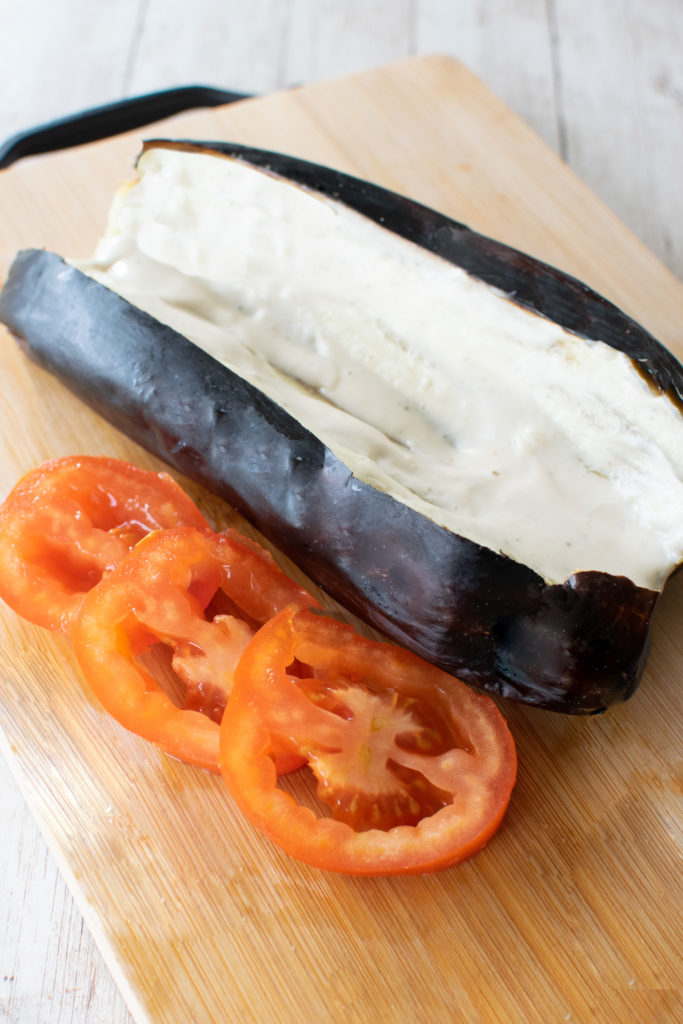
Easy Oven-Roasted Eggplant is a favorite dish to be eaten any time. While some people wrap potatoes in aluminum foil and place them in an oven or toss them into a fire, Israelis will wrap eggplant in aluminum foil and place it on a flame.
Then, they will cut it open, drizzle or pour tehini on top and eat it right out of the skin…or even with the skin, which – after it has blackened – is soft and delicious when eaten together with the cooked meat of the eggplant.
When roasted eggplant is served on a dish, it may be topped with diced tomatoes or herbs.
Eggplants can be roasted in several simple ways:
1) Roast over an open flame: Poke a fork or a knife into the eggplant in several places to allow air to escape. Then, place the eggplant over a burner with open flame on your stove (cover around the burner with aluminum foil first to protect it from the eggplant, which will leak as it cooks). Some people first wrap the eggplant in aluminum foil before placing on the flame, so whichever way works for you. Turn or reposition the eggplant every 5- 10 minutes as the part over the flame has blackened and has shriveled a bit, until the entire eggplant has blackened shriveled somewhat. This is the best way to prepare it (over an open flame), because of the smokey flavor it gives.
2) Roast over an electric stove: The same as the process above, but use a grill pan over the burner.
3) Roast in the oven: Poke a fork or a knife into the eggplant in several places to allow air to escape. Place the eggplant on a baking tray or in a baking pan lined with aluminum foil or baking paper. Place in a oven on a high temperature (400°F – you can use a higher temperature, but check more often) and turn the eggplant every 10-15 minutes or so until the entire eggplant has blackened shriveled somewhat.
4) Broil in the oven: Poke a fork or a knife into the eggplant in several places to allow air to escape. Place the eggplant on a baking tray or in a baking pan lined with aluminum foil or baking paper. Place in a oven on broil and turn the eggplant every few minutes or so until the entire eggplant has blackened shriveled somewhat.

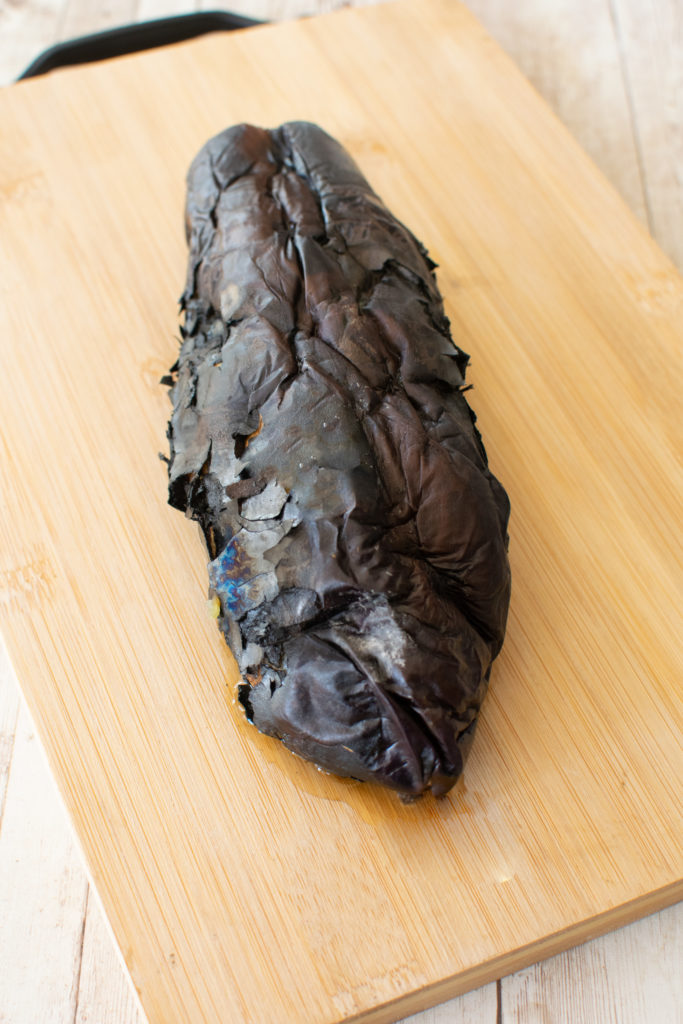
They are ready when you can easily slide a fork or knife through the skin and meat of the eggplant.
The skin becomes so soft that, if you want, you can eat it.
However many people just slice it open, sprinkle with salt and/or pepper, and eat it right out of the skin.
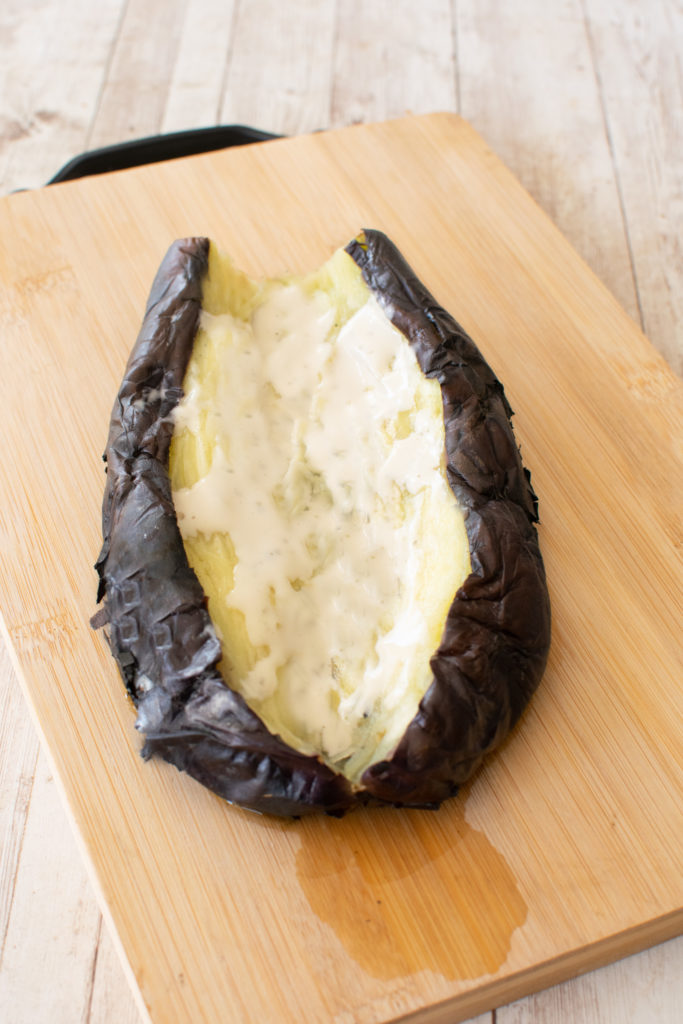
Or you can peel off the skin or scoop out the inside and place on a plate or use it to make eggplant salad, such as these: Easy Baba Ganoush and Easy Israeli Eggplant Salad.
A little of my cooking background
I really wanted to title this blog “If I can make it, anyone can” because, honestly, if I can make it, anyone can.
I never really liked cooking, and when I was single, a meal for me meant grilled cheese, eggs, tuna, or something else that didn’t require effort or time.
When my kids were young, I was still able to get away with preparing only a small variety of easy meals, but the older they got, the more dishes I learned to make at their request.
Still, I insisted on keeping it simple.
Honestly, I never understood why some cooks unnecessarily complicate meals. I have seen recipes that have several ingredients that don’t really seem to add much, if anything, to the dish. So, why bother?
It has always been important to me that whoever eats at my table will have plenty to enjoy, and that includes my kids (I never agreed with the “You will eat what is served or you won’t eat” ideology), and, because I keep it simple, I can prepare a variety of dishes in a relatively short period of time.
I have a philosophy regarding being a great cook: Prepare food according to the tastes of those who will be eating it, and they will love your cooking!
As far as I am concerned, start with the basic ingredients that make the dish what it is, adapt according to taste, and voila! You are an amazing cook!
The bottom line is that while there are certainly delicate recipes out there for specialty dishes, making delicious meals doesn’t have to be complicated or time-consuming. It’s not difficult to impress—just make sure it tastes good.
While some of the recipes on my blog are more time-consuming than others, they are all tried and true, easy-shmeezy!
Of course, one always has to consider the conditions under which they cook. Weather (humidity, heat, cold), different types of ovens, different qualities of pots, etc.—all of which can affect your cooking and baking.
Nevertheless, as I said, if I can do it, anyone can!
Everyday pantry essentials (suggested)
As I learned to prepare more and more recipes, I also learned which basics and seasonings are good to have on hand to have the ability to make a dish on short notice and not have to run out to the store or borrow from a neighbor.
While I will admit that I am not always prepared when one of my kids asks for eggplant parmesan or lasagna at the drop of a hat (which they have done), I dislike having to postpone making something just because the ingredients needed to make a reasonable meal were not readily available.
So, I maintain a selection of what I consider “pantry essentials” in my refrigerator and on my shelves at all times.
Initially, many of the herbs and spices were useful to me only on occasion (having been purchased for a particular recipe), and I usually just had them around as leftovers. However, as I began to cook more of a variety, I was really glad to have them (hey, look, I already have that!). And that is how my list began.
While, of course, most of the essentials will not be needed just for any one recipe, at least some of them are needed for most recipes, and you would be surprised how many recipes can be made just with this list. So, if you keep whatever you use regularly on hand, it can really save you time and effort.
Everyone has their favorite recipes, preferred seasonings, and just whatever they like to use to cook. Your own list should certainly reflect your own cooking tastes and style.
Just to give you an idea, the list below is a comprehensive list of what I normally keep on hand (this does not necessarily include what I keep for baking, and there may be some overlap between the two lists as some items are used for both, such as brown sugar), and, of course, it reflects the meals and desserts that I like to make for my own family and guests.
Seasoning and flavoring:
- salt (my recipes use regular table salt)
- ground black or white pepper
- granulated garlic or garlic powder (I prefer granulated)
- onion powder
- sweet paprika and/or sweet pepper flakes (paprika is ground dried red pepper, pepper flakes are crushed dried red pepper)
- hot paprika, hot pepper flakes, or cayenne pepper (moderately spicy dried ground chili pepper) for those occasional spicy dishes
- ground turmeric
- ground cumin
- ground cinnamon
- ground ginger
- ground nutmeg
- ground cloves (for pumpkin flavors)
- sugar (granulated)
- brown sugar
- chicken consommé powder / beef bouillon powder (regular or vegetarian)
- onion soup mix
- onion flakes (substitute for fresh onion—3 tablespoons for 1 medium onion).
- various herbs
- additional spices to adapt taste to preference
Misc:
- oil / margarine / butter / cooking spray
- coconut cream as a dairy-free cream substitute
- flavorless milk substitute as a dairy-free milk alternative
- cornstarch as a thickening agent
- flour
- baking powder
- baking soda
- bread crumbs or cornflake crumbs (you can make these with your blender or food processor) for coating
- condiments, such as ketchup, mustard, barbecue sauce
- tomato sauce/tomato paste/canned tomatoes—diced or crushed/pasta sauce
- soy sauce
- ready-made pie crusts and dough (to just add filling)
We always have eggs in the fridge and onions, rice, and potatoes on our shelves, as well as pasta.
In addition, having some fresh vegetables in the fridge, such as carrots, celery, tomatoes, bell peppers (various colors), etc., can be very useful when putting together a quick but delicious meal.
It is also a good idea to have some ground meat or chicken (breast, ground, or in parts) in the freezer for anyone who likes meat dishes in a snap.
Weather can have an effect on some of the spices and on the chicken consommé powder, so I keep as many of the seasonings in the refrigerator or freezer as I can, and I keep everything tightly closed in containers (you will be surprised to know just how determined moths are at getting into sealed bags and how hot red pepper powder can attract little black bugs—YUCK!).
Therefore, store your items well.
Why are these pantry essentials beneficial to have on hand?
Personally, having the above ingredients in my kitchen is very advantageous, as I make a variety of dishes and use most of the items on the list regularly enough to warrant storing them. However, I do not store items for dishes that I make seasonally or only on rare occasions or those that spoil easily.
Whether or not it is workable for you depends on your cooking style, the space you have to store, and whether or not you mind running out to the store as needed. Of course, the more you cook and the more varied your recipes, the more you will use and the more you will need.
A little about eggplants
The eggplant is native to India and Asia, where it can be found growing wild, and it is believed that eggplants were brought to Europe sometime during the 7th or 8th century.
Australians and Americans call the vegetable eggplant, while in England it is called an aubergine, from the French word for this vegetable.
Because of its meaty texture, eggplant is used instead of meat in some vegetarian versions of meat recipes.
While there are a variety of types of eggplants, the one for this recipe is the large, egg-shaped (or teardrop-shaped), blackish-purple one with the meaty inside.
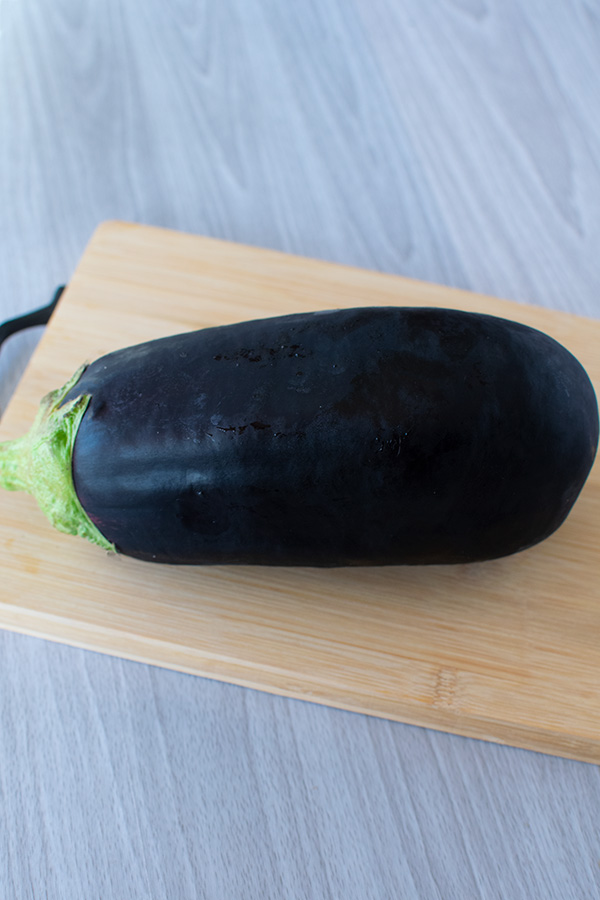
Eggplants have health benefits as they contain antioxidants like vitamins A and C, which help protect your cells against damage, and are low in calories.
About cooking eggplant
Eggplants can be roasted, baked, steamed, deep-fried, or sautéed.
Before cooking an eggplant, cut off the top part where the green is (called a calyx). The bottom tip should also be removed, but this is not imperative. The skin is perfectly fine to eat, but it must be cooked well, otherwise it may come out chewy.
This recipe can use either peeled eggplants or eggplants with the skin (having the skin on will not ruin the recipe).
Eggplant is naturally a little bitter. If you find that to be the case, you can draw out the bitterness by sprinkling it with salt and letting it sit a while. If you are using slices or pieces, slightly salt after cutting. I have personally never found this to be a problem when cooking with eggplants
Using salt before cooking can help prevent the eggplant from absorbing too much oil and becoming greasy if using oil with the eggplant recipe (I normally just pat the pieces with a paper towel if need be).
If you do use salt, MAKE SURE to rinse it off before cooking the eggplant, or the salt will become a part of your dish!
Personally, I have never salted my eggplants before using them (and I have used eggplants in two countries) and have never had any problem with bitterness, but if you have any concern, please do.
If a recipe calls for frying, but you prefer not to do so because of the calories the oil will add to the recipe, you can spray with cooking oil and bake instead.
Easy Roasted Eggplant
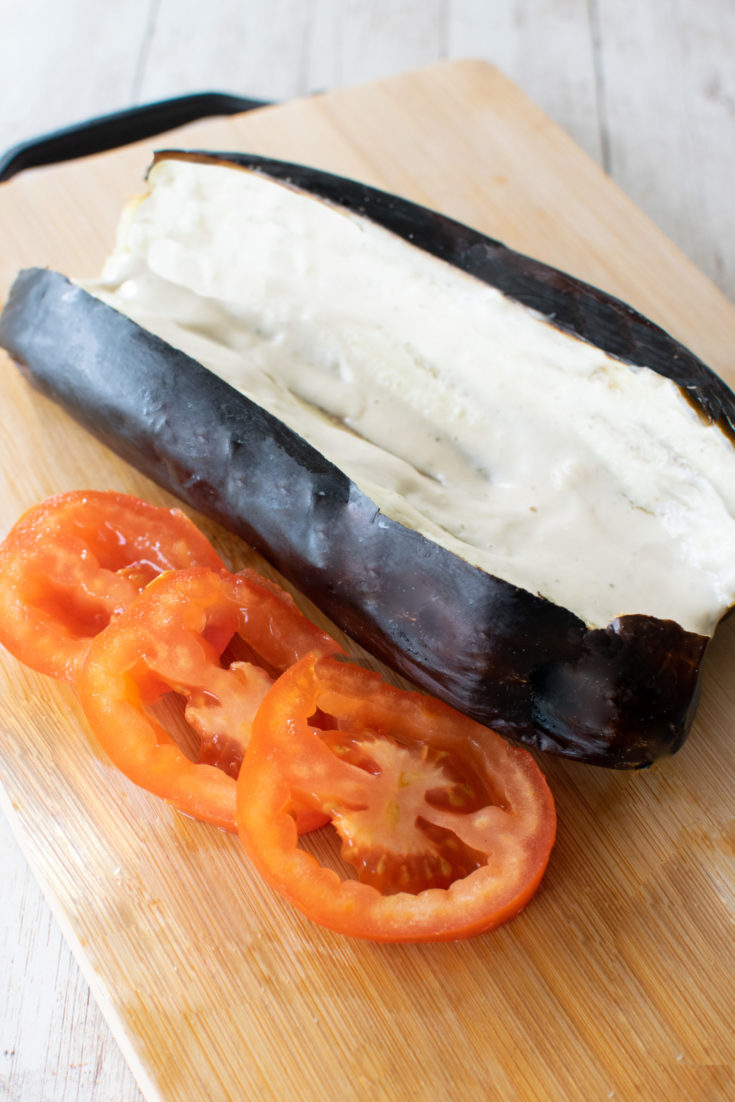
Delicious roasted eggplant , dairy-free and vegan. Just add tahini or spices.
Ingredients
- 2 medium eggplants
- 1/2 cup tehini
Instructions
- Cut off the calyx (green top) of the eggplant.
- Roast the eggplants (*See notes)
- Cut open the eggplant.
- Pour or drizzle tehini over the roasted eggplant.
- Serve alone, with diced tomatoes, with fresh herbs, etc.
Notes
* You can do this in several simple ways:
1) Roast over an open flame: Poke a fork or a knife into the eggplant in several places to allow air to escape. Then, place the eggplant over a burner with open flame on your stove (cover around the burner with aluminum foil first to protect it from the eggplant, which will leak as it cooks). Turn or reposition the eggplant every 5- 10 minutes as the part over the flame has blackened and has shriveled a bit, until the entire eggplant has blackened shriveled somewhat. This is the best way to prepare it (over an open flame), because of the smokey flavor it gives.
2) Roast over an electric stove: The same as the process above, but use a grill pan over the burner.
3) Roast in the oven: Poke a fork or a knife into the eggplant in several places to allow air to escape. Place the eggplant on a baking tray or in a baking pan lined with aluminum foil or baking paper. Place in a oven on a high temperature (400°F - you can use a higher temperature, but check more often) and turn the eggplant every 10-15 minutes or so until the entire eggplant has blackened shriveled somewhat.
4) Broil in the oven: Poke a fork or a knife into the eggplant in several places to allow air to escape. Place the eggplant on a baking tray or in a baking pan lined with aluminum foil or baking paper. Place in a oven on broil and turn the eggplant every few minutes or so until the entire eggplant has blackened shriveled somewhat.
Nutrition Information:
Yield:
4Serving Size:
1Amount Per Serving: Calories: 277Total Fat: 17gSaturated Fat: 2gTrans Fat: 0gUnsaturated Fat: 13gCholesterol: 0mgSodium: 13mgCarbohydrates: 31gFiber: 8gSugar: 9gProtein: 8g